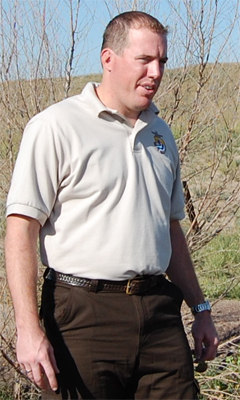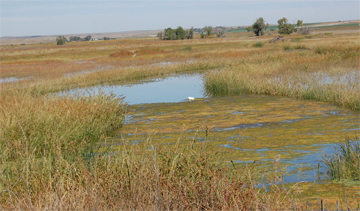U.S. Fish and Wildlife Service program restores bird habitat on farms, ranches
U.S. Fish and Wildlife Service program restores bird habitat on farms, ranches
Valerie Traina, special to mongabay
October 28, 2008
Effort is “almost more art than science”
Matt Filsinger is driving his white pickup headed northeast from Sterling to look at two of his projects. This self-described introvert speaks enthusiastically about his job.
“Ducks, ducks, ducks – that’s what I love!” says Filsinger, grinning broadly.
Filsinger is a wildlife biologist with the Partners for Fish and Wildlife Program of the U.S. Fish and Wildlife Service. He works with private landowners to set aside land and create attractive habitat for imperiled species. Specifically, he designs wetlands to attract waterfowl.
Partners for Fish and Wildlife is a successful program that has been around since 1987. Landowners, including farmers and ranchers, form partnerships with the program because they reap a variety of benefits from it. Nonprofit organizations such as Ducks Unlimited, Audubon and the Rocky Mountain Bird Observatory are also partners. Collaboration between the federal government and private landowners is essential to preserving habitat and species, as 73 percent of the country’s land is privately owned, and most wildlife lives on that land.
 Matt Filsinger |
“Nobody goes it alone,” says Filsinger, “it truly is a collaborative effort.”
On nearly empty roads, the truck rolls past countless fields of corn and alfalfa. It passes hundreds of unfarmed acres, with herds of cattle grazing here and there. It’s the perfect day to inspect his handiwork, with a clear sky overhead.
The Partners Program is dedicated to conserving federal trust species. These are animals on the “threatened” or “endangered” list or whose populations are considered imperiled. Federal trust species are generally migratory in nature or are declining in numbers on a national scale, according to their Web site.
“Matt does an excellent job of putting all the pieces together,” says Lance Kuester in a phone interview. Kuester is the mountain-prairie regional coordinator for Partners in Fish and Wildlife.
“Matt has to try to figure out what the interests are of the landowner, how to design the projects, how to work with the contractors, and if it will function as designed. Matt is also interacting with private organizations that provide funds, like Ducks Unlimited. He is a one-person show in Colorado.”
Filsinger, 31, says he took an interest in wildlife early on in life.
“I was 10 years old when I figured out that was what I wanted to do,” Filsinger says. “My father took me hunting and fishing – he loved to have someone he could do outdoor activities with.”
He says his appreciation for the outdoors grew as he did, as did opportunities in the wildlife field.
Filsinger stops his pickup at “Project MX2,” at a gate with a sign that reads, “Posted No Trespassing.” He opens the gate with a key. The landowners live elsewhere and have granted the federal government an easement to the land. The government pays them to “idle their land,” so no farming or cattle grazing is permitted. Their 320 acres were engineered for “multi-beneficial use” according to Filsinger.
The truck rolls in – a huge swath of wetlands to its left. Tall bunches of grasses are immediately visible, though the water is not. He parks and hikes on dry land through prairie cord grass, milkweed and sunflowers, to the irrigation ditch into which flows a healthy current of brown-colored water.
 Partners for Fish and Wildlife project |
Filsinger motions to the butterfly valves that control the water flow to different parts of the wetland. He points out how the land has been engineered so there are natural levees containing the wetlands.
Complex laws govern water use, Filsinger explains, and we’re now in the “free period” for water, since the irrigation season is over. In fall, winter and spring he fills the projects. The projects are lands the Partners Program is restoring.
He drives down to the wetlands along the upper bank of the natural-looking levee he’s designed. The reddish-brown grass sticking up from the marsh is “curly dock,” and it, along with “smartweed” is highly attractive to blue-winged teals, a small duck species, according to Filsinger.
He peers at the control boards placed in the ponds, which work like locks in a canal. These metal boards in a box-like structure can be slid up or down to different heights to control the depth of the water. Before leaving the property he gets out of the truck to inspect the Parshal Flume, another box-like device. Water flows into it and a recorder measures its depth.
“Wetlands are highly valuable to migratory waterfowl. As water builds up and weather moves in, the seed heads blow off and provide food for the birds,” Filsinger explains. “I am looking for a variety of species that are using project land, as opposed to many birds of the same species.”
Filsinger jumps out of the truck to lock the gate and then heads to the next destination.
Filsinger joined the Partners Program in October 2003. He’d worked for various waterfowl organizations, and for the Fish and Wildlife Service in North Dakota, after obtaining his bachelor’s degree in Wildlife and Fisheries Ecology at Oklahoma State University. On Sept. 29 he graduated from the U.S. Fish and Wildlife Service’s “Stepping Up to Leadership” program.
Greg Kernohan, program director for Ducks Unlimited in Colorado and Wyoming, met Filsinger five years ago. He says in a phone interview that the Partners Program complements that of Ducks Unlimited. His nonprofit is concerned with waterfowl habitat protection. A piece of his organization’s yearly budget is apportioned to the Partners Program. Filsinger reports back to Ducks Unlimited at the end of each fiscal year on how their money was spent.
“You’d be challenged to find a landowner that doesn’t trust him. He’s done a phenomenal job – no doubt about it,” Kernohan says of Filsinger.
 Partners for Fish and Wildlife project |
“Project MHK” located near the town of Crook, covers 750 acres and includes 11 different wetlands. On a road bordering the property, the truck passes the irrigation ditch that empties into a creek on the land. Willow trees growing along the creek banks provide “thermal habitat for bird species,” says Filsinger. One of the species is the ring-necked pheasant. Some songbirds also winter there, according to Filsinger.
“Different spots on the property are valuable to different species at different times. The goal is to have mosaics of spring, summer, fall, winter, that kind of stuff,” says Filsinger. He’s referring to the variety of native plants and grasses growing on this land.
An uninformed visitor would never know that these restored lands had been tinkered-with.
One program goal, says Filsinger, is “to make the wetlands and structures natural-looking, aesthetic, pleasing to the eye – almost more art than science.”
After touring this last project, he briefly stops at Tamarack Ranch, a state wildlife area. Filsinger inspects one of the “fish refugia ponds” on this property. This is where the Partners Program grows fish that are on the state’s threatened and endangered species list. They are growing brassy minnows there and releasing them at various restored sites.
Filsinger says that part of his job is to attend landowner meetings that are generally held in the evenings. He says his work breakdown between field and office is 50-50 over the course of a year, and 75-25 during spring and fall.
Wendy Figueroa has collaborated with Filsinger for the past two years in her role as species conservation biologist with the Colorado Division of Wildlife.
“He’s got the technical expertise to view a potential project and see it through,” she says in a phone interview. “Most people who know Matt know that he’ll go out of his way to make sure the project is successful.”
Filsinger, a Sterling resident, says he enjoys fishing and intramural sports. He also says he has fun spending time with his girlfriend and her 3-year-old daughter, doing kid-oriented activities.
When asked what he’d like to see on his gravestone, Filsinger replies: “Loved his family. Fierce friend. Loved the outdoors – which basically developed into a career in wildlife. Was happy.”













